Abstract
To identify women colonized with group B streptococci during parturition, we used pooled type-specific fluorescent antibody to examine vaginal swabs enriched by preincubation in selective broth medium. In preliminary experiments, group B streptococcus strain III-Bell was reliably detectable with fluorescent antibody at concentrations of greater than 10(5) colony-forming units per ml, achieved after 6 h of incubation of small inocula (18 to 26 colony-forming units). Of the vaginal swabs from 924 parturient women examined prospectively by both fluorescent antibody and selective bacteriology techniques, group B streptococci were isolated in 154. The sensitivity of the fluorescent antibody technique increased with increasing incubation time and ranged from 49% (3 to 6 h) to 81% (7 to 12 h) to 83% (13 to 18 h) to 93% (greater than 18 h). Colonized mothers identified within 6 h by the fluorescent antibody technique had higher rates of vertical transmission to their newborn infants (61%) than colonized mothers whose fluorescent antibody examinations were negative within this time interval (32%; P = 0.027). However, because of the timing of their admissions, none of the colonized mothers of the four infants who developed early-onset group B streptococcal sepsis were identified with fluorescent antibody until after delivery. Although its sensitivity approaches selective culture methods after 6 h of incubation, fluorescent antibody examination of vaginal swabs does not appear to offer a practical approach to identifying colonized parturient women for intrapartum antibiotic prophylaxis of group B streptococcal infection.
Full text
PDF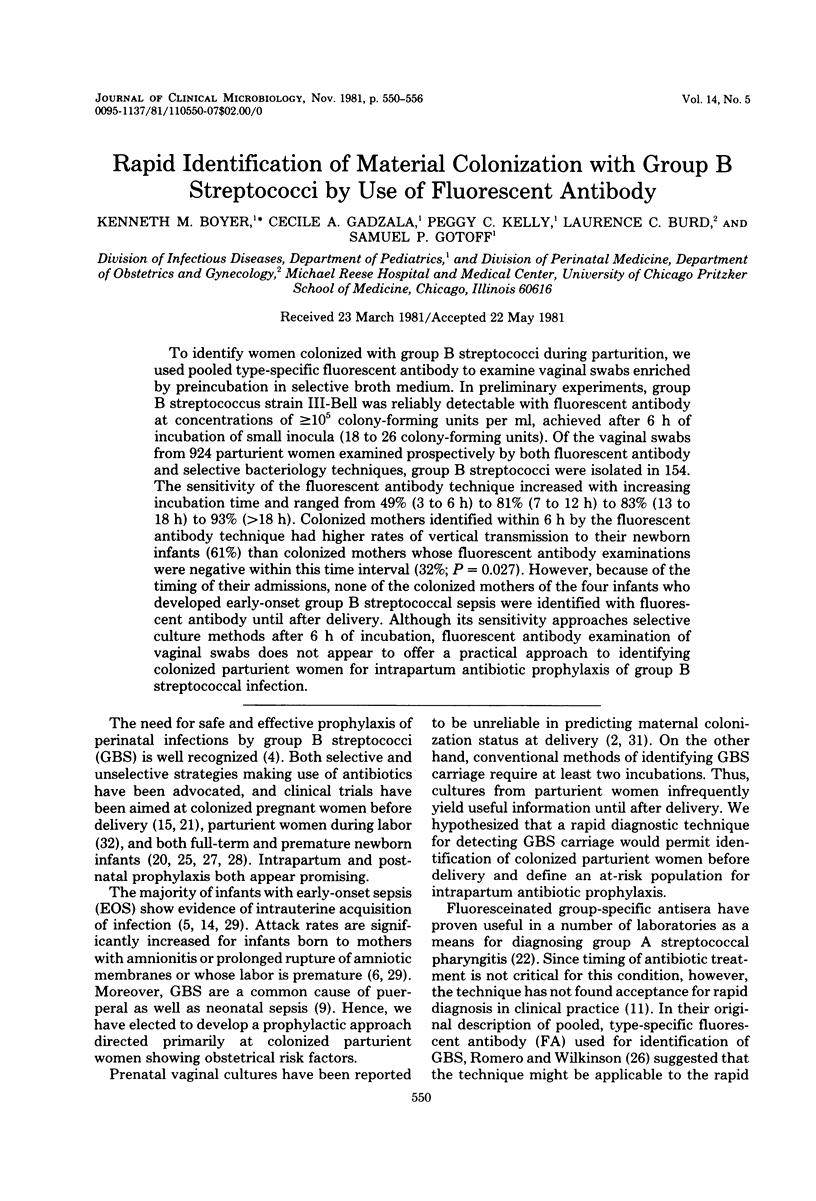


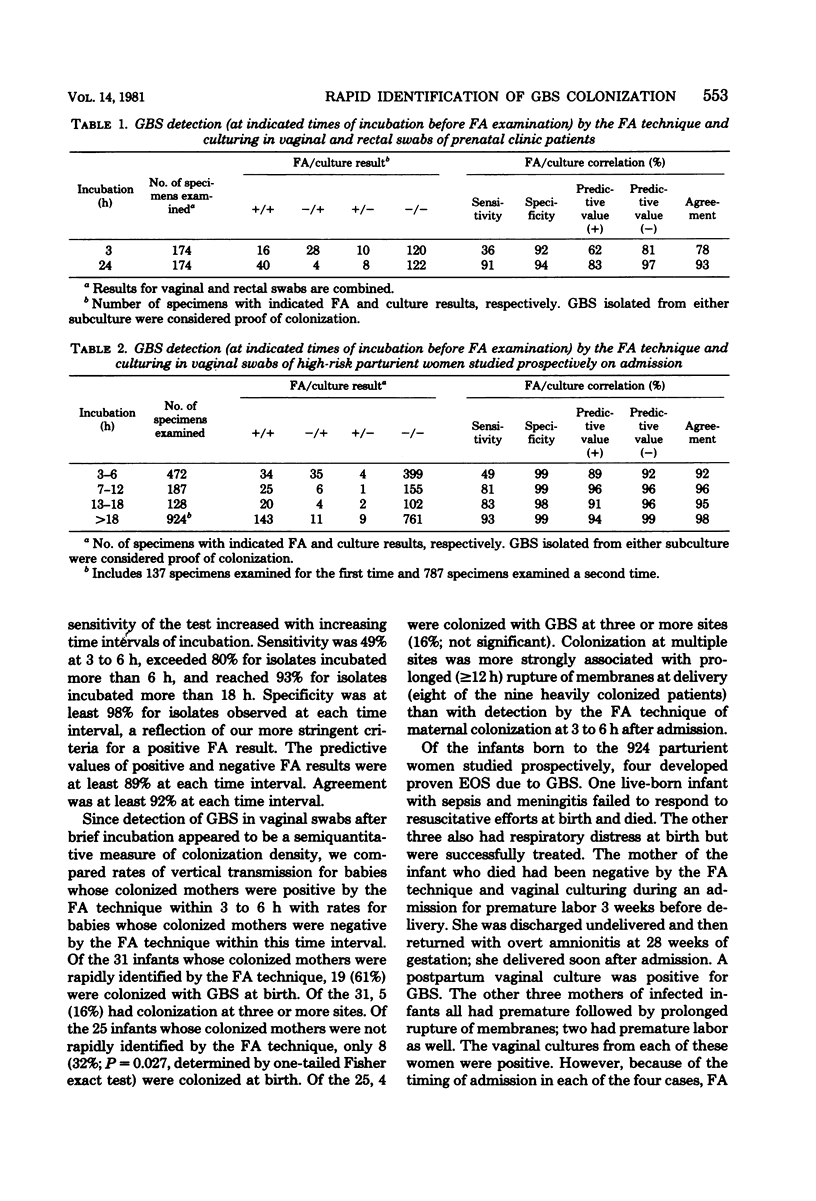
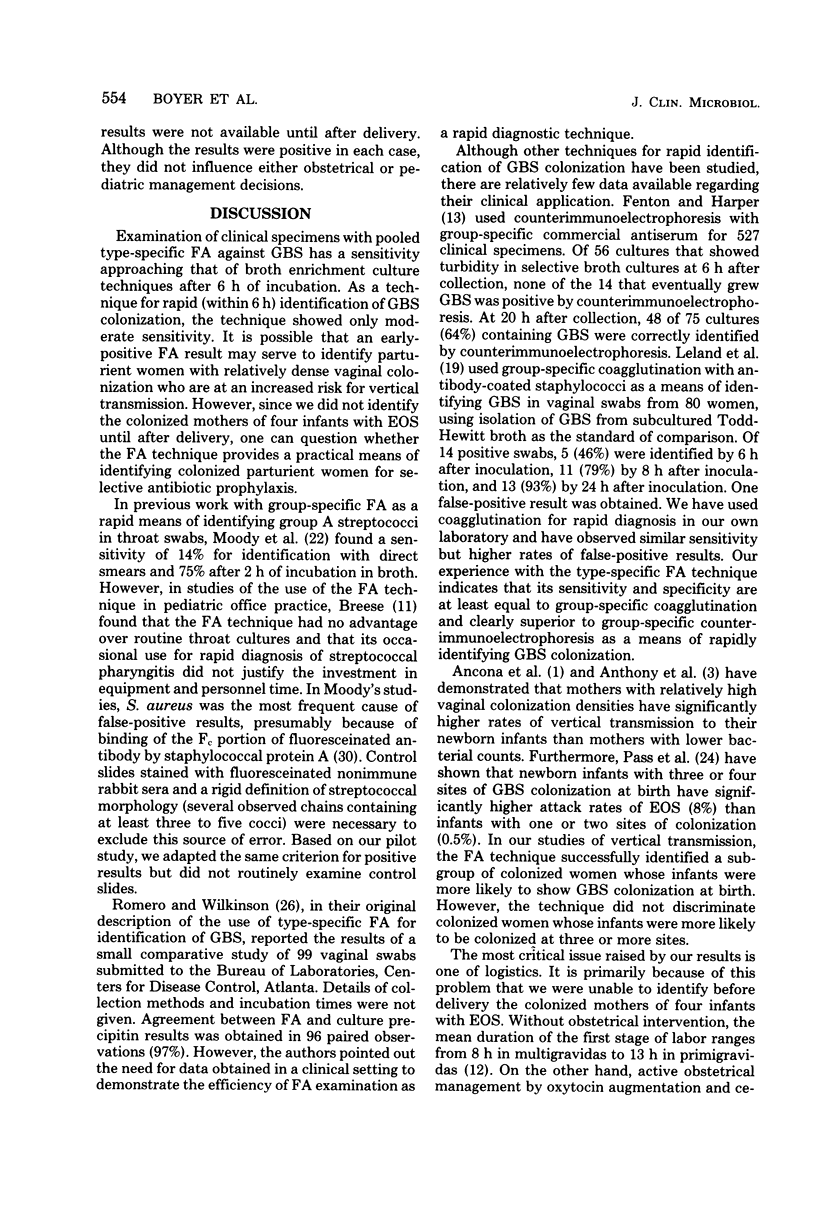
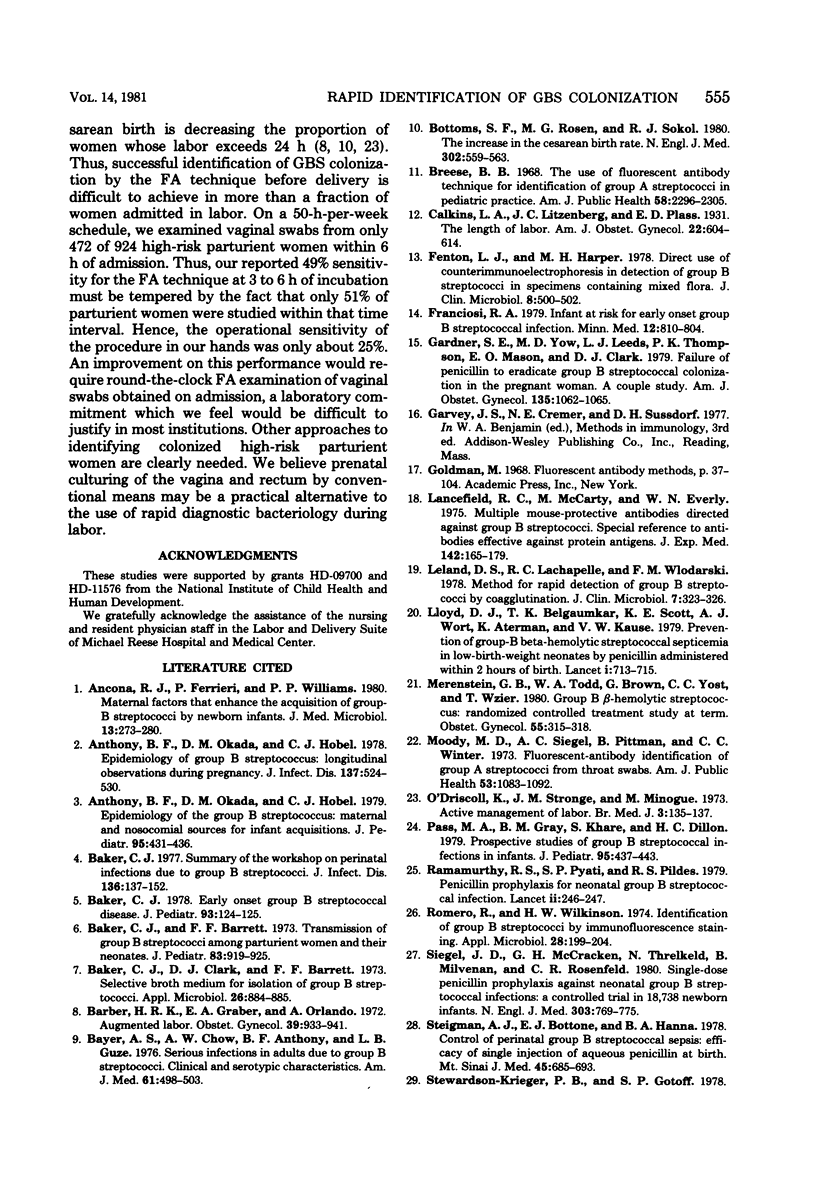
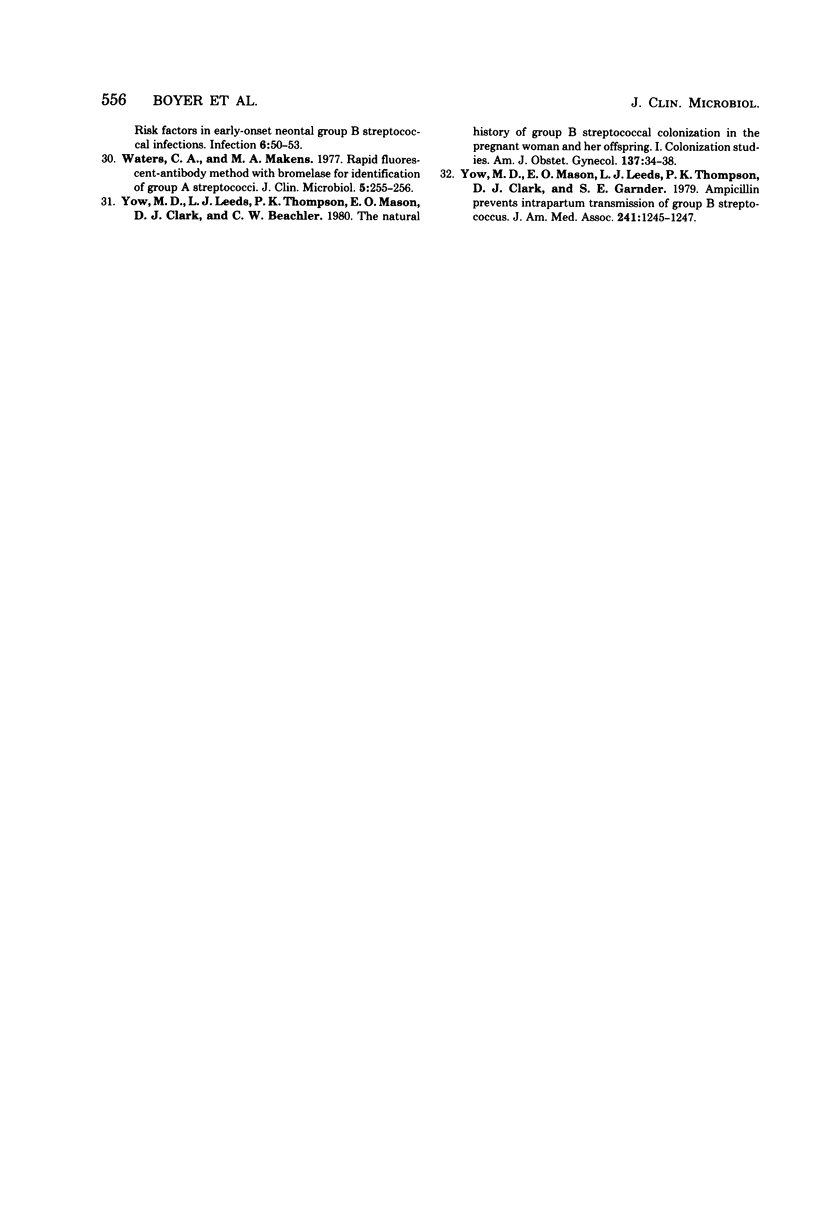
Selected References
These references are in PubMed. This may not be the complete list of references from this article.
- Ancona R. J., Ferrieri P., Williams P. P. Maternal factors that enhance the acquisition of group-B streptococci by newborn infants. J Med Microbiol. 1980 May;13(2):273–280. doi: 10.1099/00222615-13-2-273. [DOI] [PubMed] [Google Scholar]
- Anthony B. F., Okada D. M., Hobel C. J. Epidemiology of group B Streptococcus: longitudinal observations during pregnancy. J Infect Dis. 1978 May;137(5):524–530. doi: 10.1093/infdis/137.5.524. [DOI] [PubMed] [Google Scholar]
- Anthony B. F., Okada D. M., Hobel C. J. Epidemiology of the group B streptococcus: maternal and nosocomial sources for infant acquisitions. J Pediatr. 1979 Sep;95(3):431–436. doi: 10.1016/s0022-3476(79)80530-2. [DOI] [PubMed] [Google Scholar]
- Baker C. J., Barrett F. F. Transmission of group B streptococci among parturient women and their neonates. J Pediatr. 1973 Dec;83(6):919–925. doi: 10.1016/s0022-3476(73)80524-4. [DOI] [PubMed] [Google Scholar]
- Baker C. J., Clark D. J., Barrett F. F. Selective broth medium for isolation of group B streptococci. Appl Microbiol. 1973 Dec;26(6):884–885. doi: 10.1128/am.26.6.884-885.1973. [DOI] [PMC free article] [PubMed] [Google Scholar]
- Baker C. J. Early onset group B streptococcal disease. J Pediatr. 1978 Jul;93(1):124–125. doi: 10.1016/s0022-3476(78)80623-4. [DOI] [PubMed] [Google Scholar]
- Barber H. R., Graber E. A., Orlando A. Augmented labor. Obstet Gynecol. 1972 Jun;39(6):933–941. [PubMed] [Google Scholar]
- Bayer A. S., Chow A. W., Anthony B. F., Guze L. B. Serious infections in adults due to group B streptococci. Clinical and serotypic characterization. Am J Med. 1976 Oct;61(4):498–503. doi: 10.1016/0002-9343(76)90329-6. [DOI] [PubMed] [Google Scholar]
- Bottoms S. F., Rosen M. G., Sokol R. J. The increase in the cesarean birth rate. N Engl J Med. 1980 Mar 6;302(10):559–563. doi: 10.1056/NEJM198003063021006. [DOI] [PubMed] [Google Scholar]
- Breese B. B. The use of the fluorescent antibody technic for identification of group A streptococci in pediatric practice. Am J Public Health Nations Health. 1968 Dec;58(12):2295–2305. doi: 10.2105/ajph.58.12.2295. [DOI] [PMC free article] [PubMed] [Google Scholar]
- Fenton L. J., Harper M. H. Direct use of counterimmunoelectrophoresis in detection of group B streptococci in specimens containing mixed flora. J Clin Microbiol. 1978 Nov;8(5):500–502. doi: 10.1128/jcm.8.5.500-502.1978. [DOI] [PMC free article] [PubMed] [Google Scholar]
- Franciosi R. A. Infant at risk for early onset group B streptococcal infection. Minn Med. 1979 Nov;62(11):801–804. [PubMed] [Google Scholar]
- Gardner S. E., Yow M. D., Leeds L. J., Thompson P. K., Mason E. O., Jr, Clark D. J. Failure of penicillin to eradicate group B streptococcal colonization in the pregnant woman. A couple study. Am J Obstet Gynecol. 1979 Dec 15;135(8):1062–1065. doi: 10.1016/0002-9378(79)90737-3. [DOI] [PubMed] [Google Scholar]
- Lancefield R. C., McCarty M., Everly W. N. Multiple mouse-protective antibodies directed against group B streptococci. Special reference to antibodies effective against protein antigens. J Exp Med. 1975 Jul 1;142(1):165–179. doi: 10.1084/jem.142.1.165. [DOI] [PMC free article] [PubMed] [Google Scholar]
- Leland D. S., Lachapelle R. C., Wlodarski F. M. Method for rapid detection of group B streptococci by coagglutination. J Clin Microbiol. 1978 Apr;7(4):323–326. doi: 10.1128/jcm.7.4.323-326.1978. [DOI] [PMC free article] [PubMed] [Google Scholar]
- Lloyd D. J., Belgaumkar T. K., Scott K. E., Wort A. J., Aterman K., Krause V. W. Prevention of group-B beta-haemolytic streptococcal septicaemia in low-birth-weight neonates by penicillin administered within two hours of birth. Lancet. 1979 Mar 31;1(8118):713–715. doi: 10.1016/s0140-6736(79)91160-7. [DOI] [PubMed] [Google Scholar]
- Merenstein G. B., Todd W. A., Brown G., Yost C. C., Luzier T. Group B beta-hemolytic streptococcus: randomized controlled treatment study at term. Obstet Gynecol. 1980 Mar;55(3):315–318. [PubMed] [Google Scholar]
- Moody M. D., Siegel A. C., Pittman B., Winter C. C. Fluorescent-Antibody Identification of Group A Streptococci from Throat Swabs. Am J Public Health Nations Health. 1963 Jul;53(7):1083–1092. doi: 10.2105/ajph.53.7.1083. [DOI] [PMC free article] [PubMed] [Google Scholar]
- O'Driscoll K., Stronge J. M., Minogue M. Active management of labour. Br Med J. 1973 Jul 21;3(5872):135–137. doi: 10.1136/bmj.3.5872.135. [DOI] [PMC free article] [PubMed] [Google Scholar]
- Pass M. A., Gray B. M., Khare S., Dillon H. C., Jr Prospective studies of group B streptococcal infections in infants. J Pediatr. 1979 Sep;95(3):437–443. doi: 10.1016/s0022-3476(79)80531-4. [DOI] [PubMed] [Google Scholar]
- Ramamurthy R. S., Pyati S. P., Pildes R. S. Penicillin prophylaxis for neonatal group-B streptococcal infection. Lancet. 1979 Aug 4;2(8136):246–247. doi: 10.1016/s0140-6736(79)90253-8. [DOI] [PubMed] [Google Scholar]
- Romero R., Wilkinson H. W. Identification of group B streptococci by immunofluorescence staining. Appl Microbiol. 1974 Aug;28(2):199–204. doi: 10.1128/am.28.2.199-204.1974. [DOI] [PMC free article] [PubMed] [Google Scholar]
- Siegel J. D., McCracken G. H., Jr, Threlkeld N., Milvenan B., Rosenfeld C. R. Single-dose penicillin prophylaxis against neonatal group B streptococcal infections. A controlled trial in 18,738 newborn infants. N Engl J Med. 1980 Oct 2;303(14):769–775. doi: 10.1056/NEJM198010023031401. [DOI] [PubMed] [Google Scholar]
- Steigman A. J., Bottone E. J., Hanna B. A. Control of perinatal group B streptococcal sepsis: efficacy of single injection of aqueous penicillin at birth. Mt Sinai J Med. 1978 Nov-Dec;45(6):685–693. [PubMed] [Google Scholar]
- Summary of the workshop on perinatal infections due to group B Streptococcus. J Infect Dis. 1977 Jul;136(1):137–152. doi: 10.1093/infdis/136.1.137. [DOI] [PubMed] [Google Scholar]
- Waters C. A., Makens M. A. Rapid fluorescent-antibody method with bromelase for identification of group A streptococci. J Clin Microbiol. 1977 Feb;5(2):255–256. doi: 10.1128/jcm.5.2.255-256.1977. [DOI] [PMC free article] [PubMed] [Google Scholar]
- Yow M. D., Leeds L. J., Thompson P. K., Mason E. O., Jr, Clark D. J., Beachler C. W. The natural history of group B streptococcal colonization in the pregnant woman and her offspring. I. Colonization studies. Am J Obstet Gynecol. 1980 May 1;137(1):34–38. doi: 10.1016/0002-9378(80)90382-8. [DOI] [PubMed] [Google Scholar]
- Yow M. D., Mason E. O., Leeds L. J., Thompson P. K., Clark D. J., Gardner S. E. Ampicillin prevents intrapartum transmission of group B streptococcus. JAMA. 1979 Mar 23;241(12):1245–1247. [PubMed] [Google Scholar]


